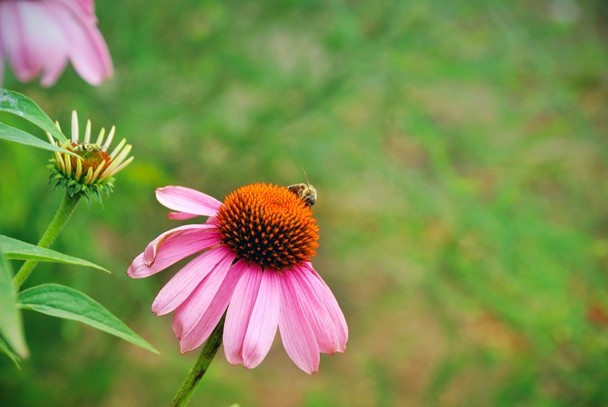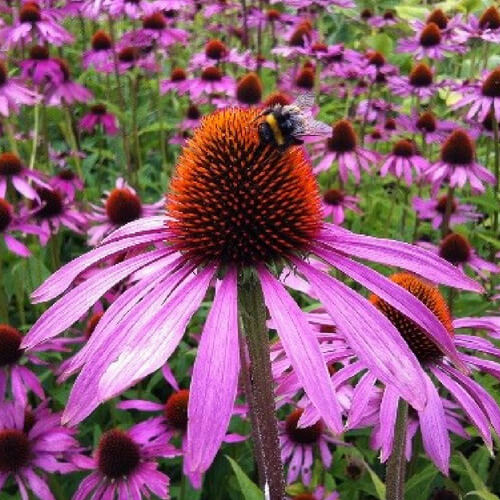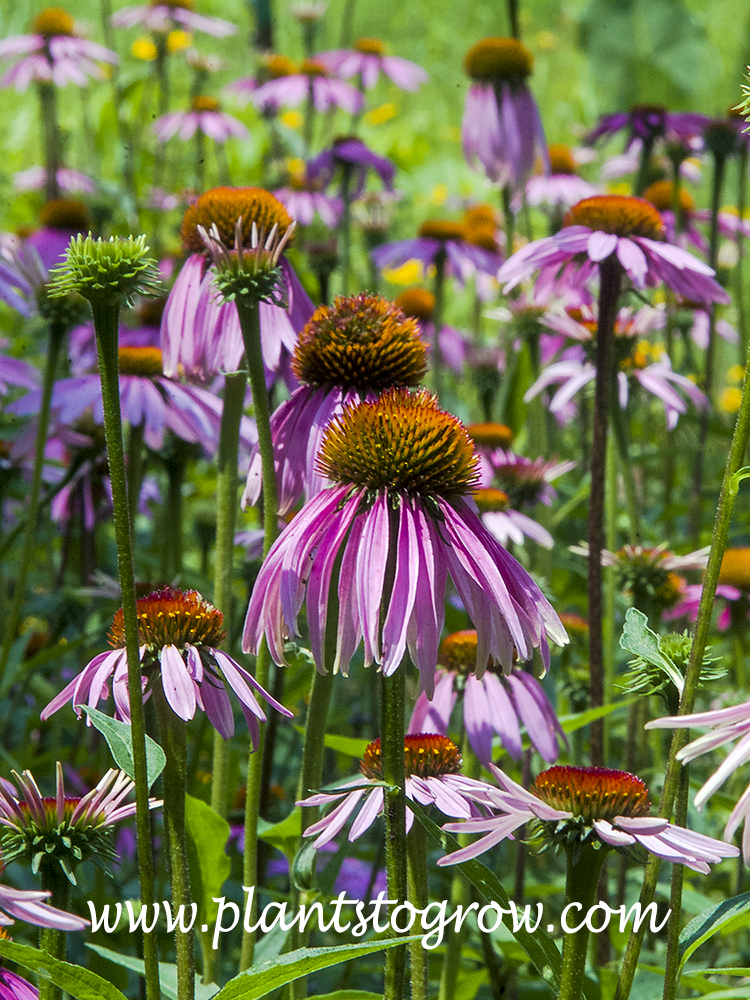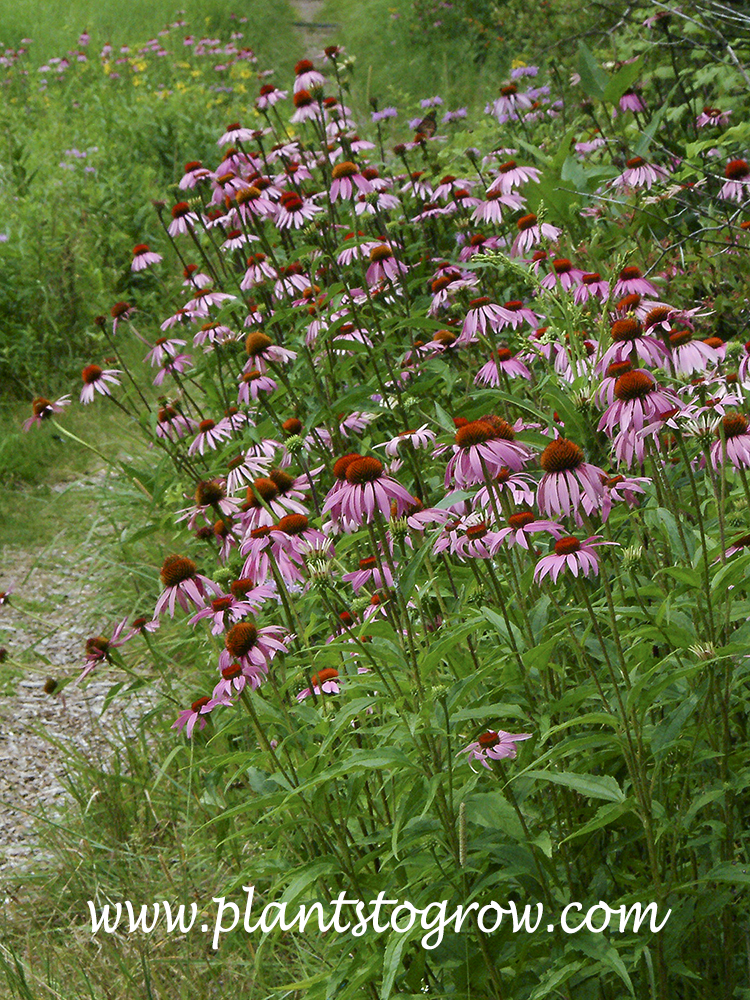

Commonly known as Purple Coneflower, this species typically grows 3 tall and. Plant Patent PP16,183 was issued January 3, 2006. Common names are from state and federal lists. Echinacea purpurea is a herbaceous perennial wildflower native to North America. Lanceolate, dark green leaves (3-6” long). Flowers bloom from June to August with some sporadic later bloom. Each daisy-like coneflower (to 5” diameter) has red-purple rays, large, pin cushion-like, dark orange central cones and an interesting fragrance.


It was discovered as a whole plant mutation in a planting of Echinacea purpurea ‘Ruby Giant’, and is primarily distinguished from ‘Ruby Giant’ by having much shorter plant height, longer and narrower leaves and deeper red-purple flowers. NATIVE STATUS: Native, United States Introduced. ‘Little Giant’ is a dwarf purple coneflower that grows to only 16” tall, but still produces large flowers. TAXONOMY: The currently accepted scientific name for purple coneflower is Echinacea purpurea (L.) Moench. Collected by the First Survey in 1838 at Gull Prairie, Kalamazoo Co., and also in St. Coefficient of Conservatism: 10 Coefficient of Wetness: 5 Wetness Index: UPL Physiognomy: Nt P-Forb. Genus name of Echinacea comes from the Greek word echinos meaning hedgehog or sea-urchin in reference to the spiny center cone found on most flowers in the genus. Scientific Name: Echinacea purpurea Common Name: PURPLE CONEFLOWER. The dead flower stems will remain erect well into the winter, and if flower heads are not removed, the blackened cones may be visited by goldfinches or other birds that feed on the seeds. Showy daisy-like purple coneflowers (to 5" diameter) bloom throughout summer atop stiff stems clad with coarse, ovate to broad-lanceolate, dark green leaves. pallida (pale purple coneflower) - purple, narrow, very downward flexing ray flowersĮ.Echinacea purpurea, commonly called purple coneflower, is a coarse, rough-hairy, herbaceous perennial that is native to moist prairies, meadows and open woods of the central to southeastern United States (Ohio to Michigan to Iowa south to Louisiana and Georgia). paradoxa (yellow coneflower) - yellow flowersĮ. Most of these new cultivars are the result of seedling selection of purple coneflower or crossing between E. Basal leaves have long stems and grow to 6 inches long they are coarsely toothed, oblong, and. Scientific Name: Echinacea purpurea Common Name: PURPLE CONEFLOWER. The ray flowers are various shades of magenta or rose-purple. Flowerheads are usually solitary, terminal, and quite large. There have been multiple new introductions of purple coneflower in many different colors. A perennial plant with large, daisy-like flowers with slightly drooping magenta petals (ray flowers).

Plants can get overcrowded and benefit from division every 4 to 6 years. Plants freely and easily re-seed throughout the garden and this can be reduced if you remove flowers after they fade and before they set seed. It is primarily grown for beautification of landscapes for the sunflower shaped.45.00 to 180. Goldfinches and other birds like the seed found in the dried black center part of the flower and spent flowers will stand through winter. Purple Coneflower is a perennial herb that grows in rocky open prairies. Deadheading will promote more repeat blooms. Plants have a big flush of bloom in first part of summer with consistent bloom (but fewer) until first frost.
Purple coneflower scientific name full#
Great flower for full sun, well drained soils. It is primarily grown for beautification of landscapes for the sunflower shaped flower with petals ranging from deep purple to a light lavender color that surround a large orange/brown disk. Scientific Name BRPU15: Brauneria purpurea (L. Purple Coneflower is a perennial herb that grows in rocky open prairies. Insects & Disease Issues: Leaf spots, Japanese beetle and aster yellows (occasionally), Culture and Uses: Click on the carousel image to display a larger version (if available). Leaves: 4-8”, dark green, coarse, serrated, short stiff hairs, alternate, simpleįlowers: June-August, purple-pink, purple, white, 3-4” diameter, brown central cone with bronze tint, slightly drooping Great pollinator plant for butterlies and other insects seed heads attract goldfinches and other birds especially during winter.Easy to grow, native perennial flower for Iowa.


 0 kommentar(er)
0 kommentar(er)
